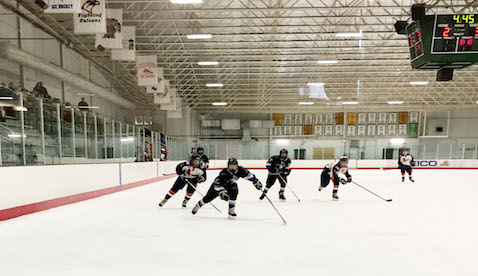By STEPHANIE GUTIERREZ-MUNGUIA AND CHRIS RIOTTA
Capital News Service

LAUREL, Md. – Some parents of young hockey-playing teens say this year’s recommendation from the American Academy of Pediatrics to ban body checking from games played by teens under 15 is worth considering.
Research shows the aggressive technique increases the likelihood of concussions in youth hockey, the doctors’ policy statement noted.
“The physicality, the [lack of] skill, being on the ice, all those things together, it causes issues,” said Lisa Weiss, former head of the Safety and Concussion Program at Reston Raiders and mother of a teenage hockey player. “They’re not old enough.”
USA Hockey, the sport’s governing body, currently allows checking in leagues for boys ages 13 and older; that minimum age was increased from age 11 before the 2011-2012 season.
But to some fans, the hard hits of body checking are just another aspect of hockey.
Harry Patrinos, whose son has been playing hockey since age 6 through the Gardens Ice House youth program in Laurel, Md., said learning body checking at a young age could increase safety.
“The sooner they learn how to do body checks and receive body checks, the better,” he said.
USA Hockey defines body checking as “any one of a number of defensive techniques, aimed at disrupting an opponent with possession of the puck, or separating them from the puck entirely.” It is often used as an aggressive way of taking control of the puck through physical force.
The governing body has said that body checking should result in a penalty during women’s games, but that isn’t the case when teen and adult males are on the ice.
Patrinos said one of the fears of banning body checks until age 15 “is that they become too big and don’t know what it means to do body check[s] and start doing it dangerously.”
Diana Parr, another parent of a hockey player in the Gardens Ice House’s ice hockey program, said banning body checks based on age does not solve safety concerns for young teens.
“The problem with the Bantam age level [13- to 14-year-olds] is such a big difference in sizes, because some kids mature earlier than other kids and you can easily have a foot difference in height in the kids of that age,” she said.
However, others said USA Hockey should look into the American Academy of Pediatrics’ recommendation from this spring.
Dr. Jon Almquist, concussion specialist at Fairfax Family Practice in Virginia, said he’d support eliminating body checking completely, “because you can still have a good sport.
“Does hockey need that checking? Does it need the fighting? I don’t think so. I think you can have a blast with the skills. And you will probably see the skills increase, too.”

Jason Hyron, manager for youth communications at USA Hockey, said the organization has already done its own research on youth body checks and is satisfied with the current age limit. He noted a ban on body checking wouldn’t necessarily mean that a practice or game in ice hockey would have zero physical contact between players.
“There will be legal body contact within the rules,” he said.
John Cole, president of the Potomac Valley Amateur Hockey Association, a Maryland league affiliated with USA Hockey, said the emphasis needs to be on training children to do skills like body checking properly. “If you look at the USA Hockey coaching curriculum, coaches are supposed to instruct on training at the Pee Wee age level now, and checking begins at the Bantum [13- to 14-year-old league] level. Now there’s an emphasis on training younger players, teaching them how to check properly.”
He added, “I know they are going to continue to look at things, but I’m comfortable with the changes USA Hockey made.”
Meanwhile, the National Hockey League, composed of 23 member professional clubs in the United States and seven in Canada, instituted a rule before the start of the 2010 men’s hockey season that outlaws body checking a player from their blind side and at the head. The league applied the ban with the hope that the number of concussions NHL players suffer each season would be reduced.
However, a July 2013 study published in PLOS One reports the number of concussions in the NHL has increased since that rule went into effect, rising from 44 to 65 in 2011, and to 85 in 2012.
Dr. Michael Cusimano, an author of the study, said he is surprised that body checking is still allowed in professional hockey.
“I don’t think there’s really a big advantage of checking in professional hockey,” he said. Cusimano said the NHL should “try taking another crack at the ban” to try to reduce the number of concussions professional players are receiving each year.


You must be logged in to post a comment.